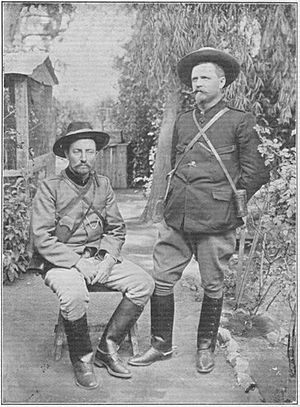Ben Viljoen facts for kids
Quick facts for kids
Benjamin Johannes Viljoen
|
|
|---|---|

General Ben Viljoen (seated) and his Secretary (Mr. J. Visser)
|
|
| Born | 7 September 1869 Varkiesdraai, Wodehouse district, Cape Colony |
| Died | 14 January 1917 (aged 47) La Mesa, New Mexico, US |
| Allegiance | |
| Years of service | 1896–1902 |
| Rank | Assistant Commandant-General Major |
| Unit | Krugersdorpse Vrywilligerskorps Transvaal Burgher Force Johannesburg Commando 1st Infantry Regiment, New Mexico National Guard |
| Battles/wars | First Boer War (1880–1881) Jameson Raid (1895–1896) Second Boer War (1899–1902)
|
| Other work |
|
Benjamin Johannes "Ben" Viljoen (born September 7, 1869 – died January 14, 1917) was an important figure in South African and American history. He was a soldier, farmer, and a general for the Boers in South Africa. Later in life, he became a diplomat and a citizen of the United States.
Ben Viljoen was born in a cave in the Wodehouse district of the Cape Colony. His family lived there while their farmhouse was being built. He grew up on a farm called Varkiesdraai near Umtata. He rose through the ranks to become an Assistant Commandant-General in the Transvaal army. He was also a member of the Transvaal Volksraad, which was like their parliament.
Contents
Early Life and Political Role
Ben Viljoen moved to Johannesburg in 1890. In 1896, he started a group called the Krugersdorpse Vrywilligerskorps. This group fought against the Jameson Raiders, who were trying to take over parts of the Transvaal.
What was the Volksraad?
The Volksraad was the parliament of the South African Republic. Ben Viljoen was a member, representing the town of Krugersdorp. He was a strong supporter of President Paul Kruger. Viljoen famously said in the Volksraad that it was time to trust in "God and the Mauser". This showed his strong belief in both faith and military strength.
Fighting in the Second Boer War
When the Second Anglo-Boer War began in 1899, Ben Viljoen was ready to fight. He first served in the Colony of Natal. He led a group of soldiers called the Johannesburg Commando.
Key Battles and Movements
Viljoen and his commando fought in the Battle of Elandslaagte on October 21, 1899. When the British army advanced, he joined other Boer leaders to try and stop them from reaching Pretoria. In May 1900, when British General Ian Standish Monteith Hamilton crossed the Vaal River, Viljoen and his Johannesburg Commando faced him. They fought alongside De la Rey and his Lichtenburg Commando.
Leading Guerrilla Warfare
After the main part of the war ended, Ben Viljoen became a leader in the guerrilla phase. This meant fighting in small, surprise attacks rather than large battles. He formed a strong commando group. It included men from Johannesburg, Krugersdorp, Boksburg, and other parts of the Transvaal.
Successful Raids and High Rank
Because of his success in guerrilla warfare, Viljoen was promoted in November 1900. He became an Assistant Commandant-General. One of his notable actions was surprising a British camp at Helvetia in December 1900. His forces temporarily captured 235 soldiers and a large gun.
Capture and Life as a Prisoner
Ben Viljoen was eventually captured on January 25, 1902, near Lydenburg. He was held as a prisoner-of-war until May 1902. His prison camp was on the island of St. Helena.
Writing His War Memoirs
While imprisoned on St. Helena, Viljoen wrote his autobiography. It was called "My Reminiscences of the Anglo-Boer War". The book shared a realistic view of the war from the Boer side. After the war, he returned to South Africa without much money. He refused to become a British citizen, which made it hard for him to have a public career. He also felt that his efforts in the war were not fully recognized.
New Life in the United States
Ben Viljoen eventually left South Africa. He moved to the United States in 1904. He first took part in the Louisiana Purchase Exposition in St. Louis, Missouri. This event included a "Boer War Circus" where scenes from the war were shown.
Settling in New Mexico
After the fair, Viljoen decided to stay in the US. He helped organize Boer communities in Doña Ana County, New Mexico. These settlements were in places like Berino, Chamberino, and La Mesa. He became very involved in local community life in the Mesilla Valley. In 1909, he became a US citizen.
Viljoen became friends with important people like President Theodore Roosevelt and New Mexico Governor George Curry. He was made a Major in the New Mexico National Guard's First Regiment of Infantry. In 1911, he went to Washington, D.C., to help promote New Mexico becoming a state.
Contributions to Agriculture and Politics
Ben Viljoen also made a big impact on farming in New Mexico. He brought in new crops and better farming methods to the Mesilla Valley. He was very interested in the creation of the Elephant Butte Dam. He also helped develop irrigation systems to bring water to the farms.
For a short time, he served as a US Consul in Germany. He also worked as a military advisor to Mexican Revolutionary leader Francisco Madero. Ben Viljoen passed away in 1917 at his farm in La Mesa, New Mexico. He is buried in the Masonic Cemetery there.
Images for kids
See also
 In Spanish: Benjamin Johannes Viljoen para niños
In Spanish: Benjamin Johannes Viljoen para niños


